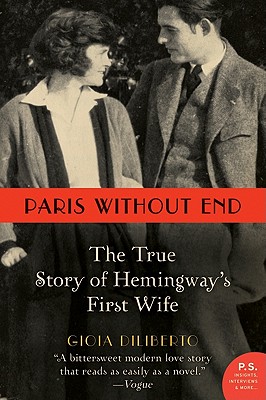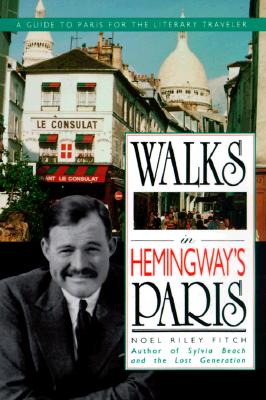American women just love The Paris Wife. Perhaps we’ve read Moveable Feast or maybe we just heard the buzz through our book club, but it seems we just love getting the scoop on Ernest Hemingway through the eyes of his first wife Hadley.
As most readers seem to have heard by now, The Paris Wife by Paula McLain (Ballantine Books 2011) is about Ernest and Hadley Hemingway’s brief but passionate years together in Paris in the early 20s. Ernest Hemingway was a charismatic and gifted writer, the genius of his generation, but he was also a narcissist, a cheater and a big drinker. No one better to deal the dirt than the first wife.
In addition to The Paris Wife, there’s an excellent nonfiction book about the same years called Paris Without End by Gioia Diliberto (Harper Perennial 2011). One of my favorite authors (she’s also written I Am Madame X, The Collection and A Useful Woman), Diliberto’s nonfiction format allows us to know more about Ernest’s developing affair with Pauline Pfeiffer than Hadley did at the time, back when Hadley was in the dark – or in denial, or a little of both. Diliberto is also able to compare the fictional events and characters in Hemingway’s stories to the real stuff going on in his life, which is a real bonus if you’re familiar with his work.
Whether you prefer the fictional drama in The Paris Wife or a more thorough nonfictional approach in Paris Without End, you’re sure to enjoy some of these Paris photographs, depicting scenes from both books. You can’t find a better Paris walk than the neighborhoods of the Latin Quarter, St. Germain and the Luxembourg Gardens. You can follow along on a Google Map here.


Ernest and Hadley moved into this apartment, at 74 rue du Cardinal-Lemoine in a working-class neighborhood of the 5th arrondissement in January, 1922. It was a two-room flat on the fourth floor without hot water or a private toilet. Hadley later said that "the apartment wasn't ghastly. In fact, it was kind of fun." She remembered that "The steep winding staircase had a niche on each flight for a step-on-two-pedals toilet."

The shop with the green awning below the Hemingways' window was once a loud and popular dance hall called Le Bal du Printemps. Ernest described it as a "noisy, rough music hall and hangout for sailor, whores, 'apaches' (French gang members) and American expatriates, who nicknamed it 'Bucket of Blood.' "

Ernest Hemingway rented an attic apartment in this building at 39 rue Descartes from 1921-1922. It served as his getaway and writing studio, and was just around the corner from his apartment with Hadley.

The plaque on the building at 39 rue Descartes giving recognition to Ernest Hemingway, although it does not appear that Hemingway continued to rent the studio after 1922.

Hadley and Ernest left Paris in August 1923 to have their baby "Bumby" in Toronto. When they returned in January 1924, they found another fairly shabby apartment at 113 rue Notre-Dame-des-Champs. It was a carpenter's loft over a working sawmill. The sawmill was torn down long ago and was replaced with the uninspiring school buildings that you see today.


The front door of the Les Blés D'Ange bakery at 151 Bis boulevard Montparnasse. Just like Ernest and Hadley, I cut through myself and stopped to buy a croissant, which I enjoyed on a bench right outside the bakery.

Ernest had no separate writing studio while they lived in the sawmill loft, , so he spent hours at the nearby café, La Closerie des Lilas, 171 boulevard du Montparnasse. You can go there today and try for the seat with the Hemingway plaque.

While Ernest worked away at Closerie des Lilas, Hadley and little Bumby would escape the apartment and go to the nearby Luxembourg Gardens. I could picture little Bumby trying to scramble around on this old tree, which certainly looks as if it would have been around in 1925.

Hemingway tended to embellish the extent of his and Hadley's poverty during their Paris years. Ernest claimed that he sometimes killed pigeons in the Luxembourg Gardens and brought them home to eat. Hadley said that wasn't true.

The site of Hadley's first post-separation apartment at 35 rue de Fleurus near boulevard Raspail. The building was torn down and the address is now a part of Alliance Française. Hadley and Ernest separated in August 1925 after it became clear that Ernest's affair with Pauline Pfeiffer would not just die out. When Ernest and Hadley first separated, he stayed in a studio loaned to him by Gerald Murphy on rue Froievaux, and Hadley stayed in the Hotel Beauvoir on avenue l'Observatoire. In October 1925, Hadley and Bumby moved in their solo apartment, which was only two doors down from Gertrude Stein.

According to Gioia Diliberto, Hadley couldn't bear to go back to their sawmill apartment, so Ernest made several trips with a handcart in order to deliver her things to her on rue de Fleurus. He is said to have pushed the handcart "weeping down the street."

Ernest and Pauline marry in May, 1926 and move into a posh apartment on rue Férou, a quiet street that leads down from the Luxembourg Gardens into Place Saint Sulpice.

Ernest and Pauline's home at 6 rue Férou, which was paid for by Pauline's uncle. According to Gioia Diliberto, it was "lavishly furnished with antiques by the bride." Pretty obvious that Ernest is no starving bohemian anymore. Nevertheless, Hadley continued to have a friendly relationship with Ernest and Pauline, and often sent Bumby to stay with them here.
I would never have been able to piece together this Hadley Hemingway tour without the help of Walks in Hemingway’s Paris: A Guide to Paris for the Literary Traveler by Noel Riley Fitch, which I highly recommend. This guide is incredibly complete, and includes walking tours of Saint Germain, Montparnasse, L’Odeon, Hemingway’s Right Bank and more. I can’t imagine a better way to explore Paris.




Thanks for a great tour of Hemingway’s Paris! Even though I’ve visited several of his apartments and favorite haunts, many of the ones you mentioned are new to me. I plan to print out this post and follow your footsteps.
LikeLike
Fabulous! I used that book on my first walk around the Left Bank, after researching Max Perkins and Fitzgerald, Hemingway and Thomas Wolfe. When I moved on to my PhD on early 20th century writers’ salons, I started with Charmed Circle, Excellent! Have led some walks myself. Check out my blog: http://www.suchfriends.wordpress.com. @SuchFriends.
LikeLike
I enjoyed reading this post tremendously! I go to Paris twice a year and I stay across the street at a lovely hotel, Hotel Grandes Des Ecole on Cardinal Lemoine. I have seen the plaque and building where Hemingway lived; however, your tutorial has helped me fill in some of the blanks. I look forward to reading The Paris Wife and your other nonfiction recommendation.
I will feature you on my FB page, Henri Loves Paris. I am sure many people will enjoy this post!
Merci,
Henri
LikeLike
Pingback: Outside my door in Paris | babyboomersmusings
How kind to share your pictures! It’s amazing many of the buildings still exist – especially the bakery and the Lila’s Cafe!!! But, that’s Paris…
Anyways…it’s intriguing to see the actual locations, but it’s kind of sad too. I just read A Moveable Feast for the first time [after being inspired by watching the movie Midnight in Paris] and the story of Hemingway’s time there is just so bittersweet.
It’s ironic that he could be so impassioned in his writing, and at the same time, so cruel to his wife and son. Perhaps he was just too young for the responsibilities of a family while he endeavored to refine his craft as a writer. At least he had the good sense in his memoir to recall his time with Hadley in a warm, sentimental fashion; and while it may not have expunged his misdeeds, at least it exposed his true feelings and gave us – and Hadley – another story to relish.
LikeLike